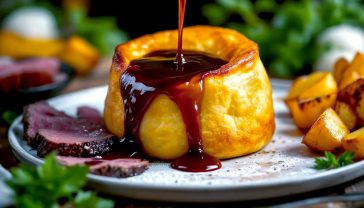The Great British Mystery of OK Sauce: More Yorkshire Than Shanghai?
It’s a staple of British takeaways, but is it actually Chinese? This definitive guide explores the secret history of OK Sauce, its ingredients, and includes a classic recipe.

This post may contain affiliate links. If you make a purchase through these links, we may earn a commission at no additional cost to you.
Picture this. It’s Friday night. The familiar, comforting scent of your local Chinese takeaway fills the kitchen. You’ve got crispy spring rolls, golden prawn toast, maybe even a portion of salt and pepper chips. And there, standing ready for action, is a bottle of thick, dark, glossy sauce. On the label, two simple letters: OK.
For decades, OK Sauce has been a silent star of the British takeaway scene. It’s that familiar sweet, tangy, and fruity flavour we reach for without a second thought. We know it’s Chinese, right? The name on the bottle often says “Oriental.” It lives next to the soy and sweet chilli. It has to be.
But what if I told you that the story of OK Sauce is not what it seems? That its roots might lie closer to the cobbled streets of London than the bustling markets of Shanghai?
This isn’t just a condiment. It’s a delicious mystery, a story of clever branding, and a taste of a uniquely British-Chinese fusion that has stood the test of time. So, let’s unscrew the cap on this takeaway classic and pour out the surprising truth. We’re going to dive deep into its history, break down exactly what gives it that addictive flavour, and even show you how to make a batch at home that’s far, far better than just ‘OK’.
What on Earth is OK Sauce? The Flavour Explained
Before we travel back in time, let’s get one thing straight: what does OK Sauce actually taste like? If you’ve never tried it, imagine a fruitier, slightly sweeter, and less peppery cousin of HP or Daddies Brown Sauce. That’s your starting point.
It’s a perfect balancing act of flavours:
- Sweet: This comes from a rich blend of fruits. Think tomatoes, dates, and apples, all cooked down into a deep, jammy base.
- Tangy: A sharp, vinegary kick cuts through the sweetness, making your taste buds tingle. This is what makes it so incredibly moreish.
- Fruity: You can taste the complex, cooked-fruit notes, like a really good chutney.
- Gently Spiced: There’s a subtle warmth from spices like cloves and cinnamon, plus a deep, savoury flavour known as umami, which it gets from a splash of soy sauce.
Its texture is just as important. It’s thick, smooth, and glossy, clinging perfectly to whatever you choose to dunk in it. It’s not a thin, watery sauce; it’s a proper, substantial condiment built for the serious business of dipping. In short, it’s the ultimate all-rounder for the deep-fried, savoury dishes we love.
The Surprising Origins: More British Than Beijing?
This is where our story takes a fascinating turn. While we call it ‘Chinese OK Sauce’, and it found its fame in Chinese takeaways, its DNA is overwhelmingly British.
To find its source, we don’t need to look to the Far East. We need to look to a London-based company called Geo Watkins, a name that might be familiar to anyone who has ever peered at the back of a bottle of mushroom ketchup or anchovy sauce.
A Victorian Legacy of Flavour
George Watkins founded his company, Geo Watkins, way back in 1830. In Victorian Britain, people were obsessed with powerful, savoury sauces and relishes. They loved condiments that could liven up cold meats, pies, and stews. Companies like Lea & Perrins (of Worcestershire Sauce fame) and H. J. Heinz were making their names, and Geo Watkins was right there with them, becoming famous for its Mushroom Ketchup.
But it was their fruity, tangy brown sauce that would eventually become a legend. They developed a recipe using a classic British pantry list: malt vinegar, dates, apples, tomatoes, and a secret blend of spices. Sound familiar? It should. It’s the blueprint for nearly every great British brown sauce.
The “Shanghai” Marketing Stroke of Genius
So, how did this very British sauce get a Chinese identity? The answer is brilliant marketing.
Sometime in the early 20th century, long before Chinese takeaways were on every high street, Britain had a fascination with ‘the Orient’. Chinese art, fashion, and culture were seen as exotic and sophisticated. Geo Watkins, likely spotting an opportunity, branded their fruity brown sauce as “OK Sauce” and marketed it with an Eastern flair. Some bottles were even labelled “Shanghai OK Sauce.”
It wasn’t a recipe from Shanghai; it was a sauce for a British public intrigued by Shanghai. By giving it an exotic name, they made it stand out from the dozens of other brown sauces on the shelf. It was a simple, clever trick, and it worked. The name was short, memorable, and suggested a quality that was universally understood. It was… OK. And in this case, OK meant reliable, tasty, and exactly what you wanted.
The Takeaway Boom
The sauce remained a well-liked but relatively minor player for decades. Its true moment in the spotlight arrived after World War II, with the boom of Chinese takeaways in the 1950s and 60s.
As families from Hong Kong and Canton settled in the UK, they opened restaurants and takeaways, adapting their incredible cuisine for the British palate. They needed condiments that would appeal to their new customers. While they introduced Britain to classics like sweet and sour, they also needed a familiar, all-purpose sauce for dipping spring rolls, egg-fried rice, and, of course, chips.
OK Sauce was the perfect fit. Its sweet and tangy profile was a brilliant match for fried foods, and its “Oriental” branding made it feel like an authentic part of the experience. It was a ready-made bridge between British and Chinese flavours. Takeaway owners bought it in huge catering-sized tubs, and it quickly became the default brown sauce of the British Chinese takeaway, cementing its legendary status.
Deconstructing the Bottle: The Ingredients That Make OK Sauce Tick
The official recipe for Geo Watkins OK Sauce is a closely guarded secret, but the ingredients list gives us all the clues we need. It’s a wonderful symphony of simple, powerful flavours working together. Let’s break it down.
The Fruity Foundation: A Trio of Sweetness
The heart and soul of OK Sauce is its fruit base. It’s not just one fruit, but a team effort.
- Tomatoes: Just like in ketchup, tomatoes provide a sweet, slightly acidic, and savoury foundation. They give the sauce its body and familiar reddish-brown colour.
- Dates: This is the secret weapon for deep, rich sweetness. Dates provide a dark, caramelly, almost treacle-like flavour that you just can’t get from sugar alone. It’s what gives OK Sauce its luxurious character.
- Apples: To stop the sauce from being too heavy, apples bring a sharper, fresher, and tangier kind of sweetness. They help to brighten the whole mixture.
The Tangy Kick: Vinegar’s Vital Role
If fruit is the heart of OK Sauce, then vinegar is its backbone. The unmistakable tang comes from malt vinegar, the classic, sharp, and slightly sweet vinegar used in everything from fish and chips to pickled onions. It’s the ingredient that firmly plants OK Sauce in the British brown sauce family. The acidity of the vinegar is crucial; it cuts through the richness of fried food and keeps you coming back for more.
The Exotic Twist: Spices and Aromatics
This is what sets OK Sauce apart from its plainer cousins. A carefully chosen blend of spices adds warmth, depth, and that little hint of mystery.
- Tamarind: This is a key player. Tamarind is a sour fruit used widely in Asian and African cooking. It has a unique sweet-and-sour flavour that is much more complex than vinegar alone. It adds an exotic tang that subtly hints at the sauce’s “Oriental” identity.
- Spices: The exact blend is a secret, but it almost certainly includes warming spices like cloves, cinnamon, and mace. There might be a pinch of ginger or cayenne for a very mild background heat. These spices are what you smell when you open the bottle.
- Soy Sauce: Here is the most direct link to Chinese cuisine. A splash of soy sauce is added to the mix, bringing a salty, savoury depth (umami) that rounds out the sweetness of the fruit and the sharpness of the vinegar.
The Secret Thickeners and Sweeteners
To get that famous glossy shine and thick texture, commercial recipes use modified cornflour (starch). This ensures the sauce is perfectly smooth and stable. Extra sweetness and a dark colour often come from molasses or treacle, which adds another layer of deep, slightly bitter flavour.
The Great British Sauce Showdown: OK Sauce vs. The Contenders
To truly understand OK Sauce, it helps to see how it stacks up against the other bottles in the national cupboard.
OK Sauce vs. HP Sauce: A Tale of Two Cousins
This is the big one. They look similar, they smell similar, but they are not the same.
- Similarities: Both are built on a base of malt vinegar, tomatoes, dates, and tamarind. They are undeniably part of the same family.
- Differences: HP Sauce is generally more savoury and peppery. It has a more aggressive, spiced flavour. OK Sauce is noticeably sweeter and fruitier. The date and apple flavours are more prominent, and the spicy notes are much more subdued. Think of HP as the loud, peppery uncle and OK Sauce as the sweeter, gentler aunt.
OK Sauce vs. Cantonese Sauce: Spot the Difference
This often causes confusion at the takeaway counter.
- Cantonese Sauce: This is a bright, sweet, and sour sauce, but it’s very different from OK Sauce. It’s typically a vibrant orange-red colour and gets its flavour from ingredients like pineapple, vinegar, and ketchup. It’s much simpler and often has chunks of pineapple, peppers, and onions in it.
- OK Sauce: Darker, thicker, and far more complex. The flavour is based on dark fruits and spices, not pineapple. If you order “Crispy Shredded Chicken in OK Sauce,” you’ll get a dish coated in a rich, tangy, dark brown glaze.
OK Sauce vs. Sweet and Sour Sauce
The classic bright red or orange dipping sauce is a world away from OK Sauce. That familiar sweet and sour is usually a very simple mix of sugar, vinegar, and a colouring agent, sometimes with a bit of ketchup or fruit juice. It’s purely sweet and sour, with none of the spiced, fruity complexity of OK Sauce.
The Ultimate Homemade OK Sauce Recipe: Bring the Takeaway Home
Making your own OK Sauce is incredibly rewarding. You can control the sweetness and tang, you know exactly what’s in it (no strange additives!), and the flavour is unbelievably fresh and vibrant. This recipe creates a sauce that is deeply fruity, perfectly balanced, and tastes even better than the stuff from the bottle.
Ingredients:
- 1 medium onion, finely chopped
- 1 clove of garlic, crushed
- 1 cooking apple (like a Bramley), peeled, cored, and roughly chopped
- 150g pitted dates, roughly chopped
- 400g tin of chopped tomatoes
- 250ml malt vinegar
- 100g dark brown muscovado sugar
- 2 tbsp molasses or black treacle
- 2 tbsp tamarind paste
- 1 tbsp soy sauce
- ½ tsp ground cloves
- ½ tsp ground mace (or nutmeg)
- ¼ tsp cayenne pepper (optional, for a tiny bit of warmth)
- A splash of vegetable oil
Step-by-Step Instructions:
- Sauté the Base: Heat a splash of oil in a medium, heavy-bottomed saucepan over a medium heat. Add the finely chopped onion and cook gently for 5-7 minutes until soft and translucent, but not browned. Add the crushed garlic and cook for one more minute until fragrant.
- Add the Fruit and Tomatoes: Tip the chopped apple and dates into the pan. Stir everything together and cook for another 5 minutes, allowing the fruit to soften slightly. Pour in the tin of chopped tomatoes, give it a good stir, and bring the mixture to a gentle simmer.
- Pour in the Liquids: Once simmering, carefully pour in the malt vinegar. Add the dark brown sugar, molasses (or treacle), tamarind paste, and soy sauce.
- Spice it Up: Sprinkle in the ground cloves, mace (or nutmeg), and the cayenne pepper if you’re using it. Stir thoroughly until the sugar has dissolved and everything is well combined.
- Simmer and Soften: Bring the sauce back to a gentle simmer. Turn the heat down to low, partially cover the pan with a lid (leaving a small gap for steam to escape), and let it bubble away very gently for at least 1 hour. Stir it every 15 minutes to stop it from catching on the bottom. The sauce is ready for the next step when the fruit is completely soft and the whole mixture has thickened and darkened.
- Blitz to Perfection: Turn off the heat and let the sauce cool down for 10-15 minutes. It’s much safer to blend when it’s not piping hot. Using a stick blender, blitz the sauce directly in the pan until it’s completely smooth. If you don’t have a stick blender, carefully transfer it in batches to a regular blender and blend until silky.
- The Final Sieve (Optional but Recommended): For a truly professional, silky-smooth texture just like the original, push the blended sauce through a fine-mesh sieve into a clean bowl. Use the back of a spoon to work it all through. This will remove any tiny remaining bits of skin or seeds.
- Bottle and Mature: Pour the finished sauce into sterilised glass bottles or jars. Seal them and store the sauce in the fridge.
Pro Tips for the Perfect Sauce:
- Patience is Key: The long, slow simmer is essential. It’s what allows all the flavours to melt together and deepen. Don’t rush it!
- Taste and Tweak: Before you bottle it, give your sauce a taste. Want it sweeter? Add a little more sugar. Tangier? A tiny splash more vinegar.
- Let it Mature: Your homemade OK Sauce will taste great straight away, but it will be even better after a day or two in the fridge. The flavours will settle and become even more complex.
- Storage: Kept in a sterilised, airtight bottle in the fridge, your sauce will last for at least a month.
How to Use OK Sauce: Beyond a Dollop on Your Chips
OK Sauce is one of the most versatile condiments you can have. While it’s the king of dipping, it can do so much more.
- The Classics: This is its home turf. Serve it as a dip for spring rolls, prawn toast, chicken balls, wontons, and chips. It’s also fantastic with sausages and bacon sandwiches, acting as a superb alternative to regular brown sauce.
- As a Marinade: Its sweet and tangy profile makes it a brilliant marinade. Coat pork ribs or chicken wings in OK Sauce and leave for a few hours before baking or grilling. The sugars will caramelise into a beautiful, sticky glaze.
- In Stir-Fries: Add a generous spoonful to a stir-fry in the last minute of cooking. It will create an instant, glossy sauce that clings to the vegetables and meat. It’s particularly good with beef or chicken.
- As a Glaze: Use it to glaze a roasted ham or pork loin for the last 20 minutes of cooking. The result is a stunning, flavour-packed crust.
- In Casseroles and Stews: A tablespoon of OK Sauce can add a surprising depth and a touch of fruity sweetness to a rich beef or lamb casserole.
The Enduring Legacy: Why We Still Love This Oddball Sauce
In a world full of authentic, regional sauces from every corner of the globe, why does this quirky, British-made, Chinese-branded condiment still hold a place in our hearts?
The answer is simple: nostalgia.
OK Sauce is the taste of countless Friday nights. It’s the flavour of a treat after a long week. For many, it’s a non-negotiable part of the takeaway ritual. It represents a unique and delicious chapter in British food history—a time when two cultures met in the kitchen and created something new, something perfectly suited to the tastes of the nation.
It’s a monument to clever branding and a reminder that sometimes, the story behind our food is just as rich and satisfying as the food itself. While newer, perhaps more ‘authentic’ sauces have appeared on the scene, OK Sauce endures because it’s familiar, it’s comforting, and it’s reliably, deliciously, more than just ‘OK’.
Conclusion: More Than Just ‘OK’
So, the next time you’re sitting down with your takeaway, take a closer look at that bottle of dark, glossy sauce. It’s not just a simple condiment. It’s a piece of history. It’s a British sauce, born in Victorian London, that put on an exotic costume and found its home in the heart of the nation’s Chinese takeaways.
It’s a testament to the fact that food doesn’t have to be ‘authentic’ to be wonderful. It just has to taste good. And OK Sauce, with its perfect balance of sweet, tangy, and fruity notes, tastes very, very good indeed. It’s a true original, a cross-cultural culinary hero, and a permanent fixture in the great British sauce pantheon.
Further Reading:
- The Foods of England Project – A fantastic resource for the history of traditional English foods and brands.
- Let’s Look Again – History of Geo. Watkins – A historical look at the original makers of OK Sauce.
- BBC Good Food – Condiment Recipes – For those wishing to explore making other classic sauces from scratch.






